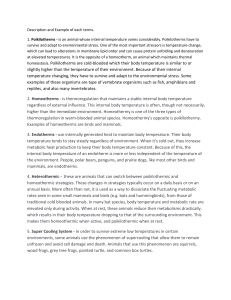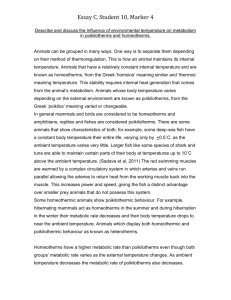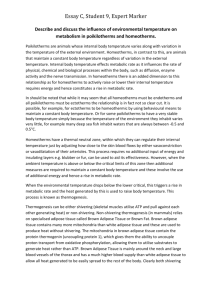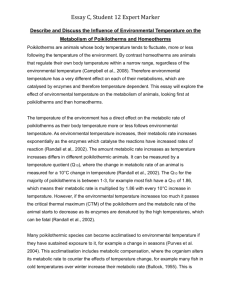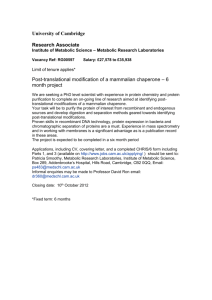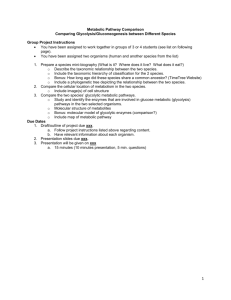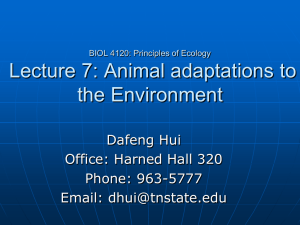expertessay11
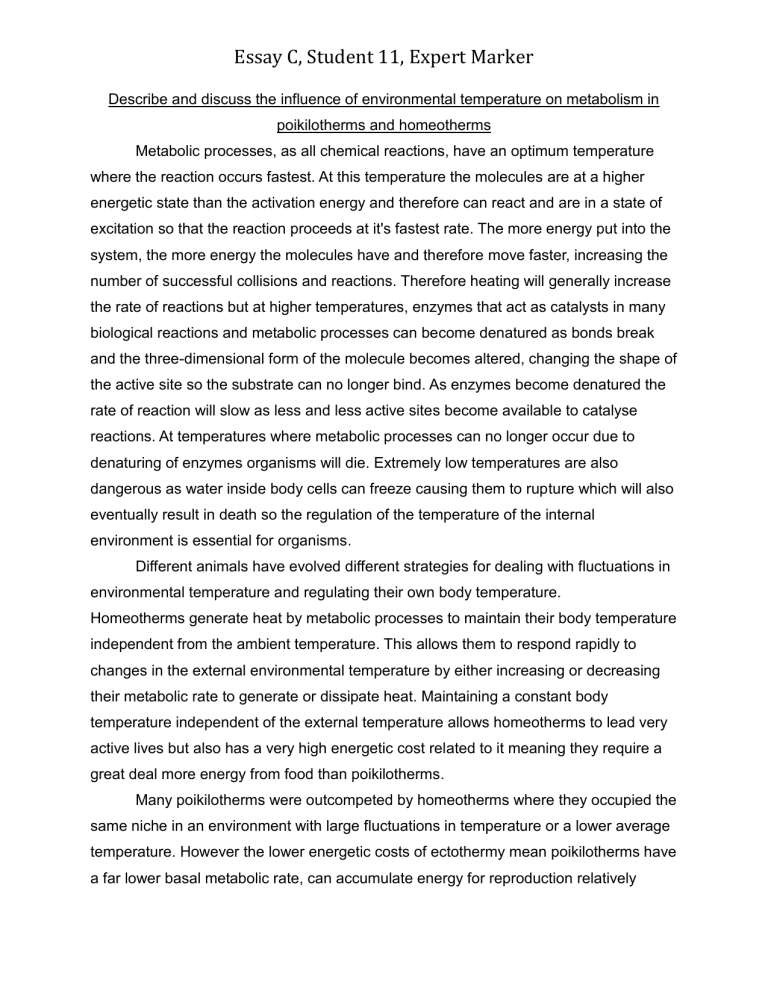
Essay C, Student 11, Expert Marker
Describe and discuss the influence of environmental temperature on metabolism in poikilotherms and homeotherms
Metabolic processes, as all chemical reactions, have an optimum temperature where the reaction occurs fastest. At this temperature the molecules are at a higher energetic state than the activation energy and therefore can react and are in a state of excitation so that the reaction proceeds at it's fastest rate. The more energy put into the system, the more energy the molecules have and therefore move faster, increasing the number of successful collisions and reactions. Therefore heating will generally increase the rate of reactions but at higher temperatures, enzymes that act as catalysts in many biological reactions and metabolic processes can become denatured as bonds break and the three-dimensional form of the molecule becomes altered, changing the shape of the active site so the substrate can no longer bind. As enzymes become denatured the rate of reaction will slow as less and less active sites become available to catalyse reactions. At temperatures where metabolic processes can no longer occur due to denaturing of enzymes organisms will die. Extremely low temperatures are also dangerous as water inside body cells can freeze causing them to rupture which will also eventually result in death so the regulation of the temperature of the internal environment is essential for organisms.
Different animals have evolved different strategies for dealing with fluctuations in environmental temperature and regulating their own body temperature.
Homeotherms generate heat by metabolic processes to maintain their body temperature independent from the ambient temperature. This allows them to respond rapidly to changes in the external environmental temperature by either increasing or decreasing their metabolic rate to generate or dissipate heat. Maintaining a constant body temperature independent of the external temperature allows homeotherms to lead very active lives but also has a very high energetic cost related to it meaning they require a great deal more energy from food than poikilotherms.
Many poikilotherms were outcompeted by homeotherms where they occupied the same niche in an environment with large fluctuations in temperature or a lower average temperature. However the lower energetic costs of ectothermy mean poikilotherms have a far lower basal metabolic rate, can accumulate energy for reproduction relatively
Essay C, Student 11, Expert Marker easily and have increased fitness in environments where food is more limited and could not support a population of homeotherms. Poikilotherms do not generate their own body heat and instead rely on heat from their environment to drive metabolic processes so their body temperature will often closely follow that of the environment and will change with fluctuations in the ambient temperature. They are therefore more reliant on behavioural adaptations to regulate their body temperature.
At low temperatures the body temperature of a poikilotherm will be similarly low and the animal may be in a state of torpor with a very low metabolic rate. In contrast, a homeotherm's metabolic rate will be incredibly high to generate the heat to compensate for the low ambient temperature and maintain the homeotherm's significantly higher body temperature.
As temperature increases the metabolic rate of a homeotherm will decrease as less heat is needed to maintain body temperature, whereas the poikilotherm's metabolic rate and body temperature will gradually increase allowing the animal to become more active. To absorb heat from their environment most efficiently, poikilotherms such as lizards will often bask in sunshine. The galapagos marine iguana raises its body temperature as the sun rises by aligning its body so the rising sun strikes its flanks, the greatest surface area so as to absorb the heat as efficiently as possible. Once their body temperature reaches its optimum level they turn to face the sun to reduce the surface area exposed to the rays. As they warm even more they will raise their bodies from the hot rocks to allow the wind to circulate beneath them and dissipate heat by convection and eventually the iguanas will seek shade to avoid overheating. As their body temperature rises, their metabolic rate also increases allowing them to become more active and seek food in the frigid coastal waters. (D. Attenborough, 1979)
Unlike poikilotherms, the metabolic rate of homeotherms decreases as their body temperature approaches it's optimum and their lowest metabolic rate occurs when the environmental temperature is the same as their optimum body temperature as the animal does not need to generate heat or expend energy to dissipate it to avoid overheating.
Above the upper critical temperature, active heat loss is required and metabolic rates for homeotherms will increase again as they must use energy to actively lower
Essay C, Student 11, Expert Marker their body temperature by mechanisms such as panting or sweating.
In spite of environmental temperature having very different effects on the metabolic rates of poikilotherms and homeotherms, each system of regulating body temperature has its advantages and allows the animals to exploit different niches and survive in often hostile environments.
References
Attenborough, D. (1979), Life on Earth, William Collins and sons12 th reprint edition.
Santos, E. (2011), Lecture notes, [ Temp I, 1 st
February 2011 ].
Santos, E. (2011), Lecture notes, [ Temp Ii, 7 th February 2011 ].
